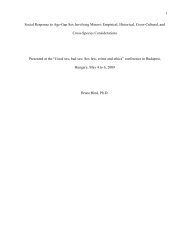Infant and Child Sexuality: A Sociological Perspective - Ipce
Infant and Child Sexuality: A Sociological Perspective - Ipce
Infant and Child Sexuality: A Sociological Perspective - Ipce
Create successful ePaper yourself
Turn your PDF publications into a flip-book with our unique Google optimized e-Paper software.
oys. They were not markedly different from black girls on any item except<br />
attitude toward marriage <strong>and</strong>, in fact, showed a higher level of<br />
heterosexual interaction at twelve <strong>and</strong> thirteen than the girls did.<br />
This high level of preadolescent heterosexual interest involvement<br />
among black boys, together with an apparent progressive disenchantment<br />
with marriage, suggests that the pattern of socio-sexual development in<br />
the black subculture may differ from the dominant white culture. There<br />
were differences in fathers’ occupations <strong>and</strong> in family structure as<br />
well, however.<br />
In sum, sociological <strong>and</strong> anthropological data cast serious doubt on<br />
the universal applicability of the concept of preadolescent sexual latency.<br />
There has been a change over the years both in the attitude of<br />
boys <strong>and</strong> girls in the United States toward heterosexual involvement <strong>and</strong><br />
in their experiencing of it. There has been a marked change toward<br />
greater heterosexual experience of preadolescents with their peers.<br />
Studies done in the twenties <strong>and</strong> thirties report unequivocally that the<br />
percentage of friendship choices extended across the sex “barrier”<br />
dropped to near zero in about the third or fourth grade <strong>and</strong> remained<br />
there through the eighth grade, after which a slight rise was discernible.<br />
In 1930 Furfey summarized his careful <strong>and</strong> systematic observations<br />
of boy-girl relations at this age concluding that girls were<br />
rigorously excluded from participation in masculine activities. “The<br />
girl, however, does not feel the affront very keenly since she has the<br />
same negative attitude toward boys that they have toward her.” (Furfey,<br />
1930, p. 101). Furfey noted that from the time boys were age eight<br />
to eleven years old until they reached puberty there was a strong distaste<br />
for playing with girls, <strong>and</strong> only 20 percent of the boys did so.<br />
Lehman <strong>and</strong> Witty (1927) found that from six to twelve years there was a<br />
definite tendency for one-sex play, <strong>and</strong> games at this age were sexlinked.<br />
This is not to say that there were no exceptions. Romance has always<br />
been an experience of some preadolescents. For example, Furfey described<br />
Max, a twelve year old boy, who openly <strong>and</strong> ardently declared<br />
his affection for his sweetheart. In commenting on the situation, Furfey<br />
wrote, “Although love affairs are common enough among twelve year<br />
olds in fiction, a case like Max’s is very rare in real life.” Furfey<br />
believed this devotion to a girl before adolescence to be uncommon <strong>and</strong><br />
a distinctly precocious trait. (Furfey, 1930, p. 28).<br />
Campbell, in 1939, in describing the typical twelve to thirteen<br />
year old girl wrote, “She would not admit that a certain boy is attractive<br />
to her, though she begins to take a covert interest.” (Campbell,<br />
1939). This picture of generally disinterested boys <strong>and</strong> covertly interested<br />
girls contrasts with the situation of recent decades. Empirical<br />
evidence reveals, as in the study by Broderick <strong>and</strong> Fowler (1961), that<br />
the majority of children in each grade claimed to have a sweetheart,<br />
<strong>and</strong> most of these expected reciprocation. Moreover, the majority of<br />
them did not keep their feelings to themselves. That these children, in<br />
fact, did discuss their romances with others is borne out by the ability<br />
of their classmates to list the sweetheart pairs in their schoolroom<br />
with considerable accuracy, especially in those cases where the<br />
relationship was reciprocal or believed by one member to be reciprocal.<br />
Hollingshead, reporting in 1949, stated that the most adventurous<br />
youngsters began to date at the age of twelve <strong>and</strong> among the thirteen<br />
121
















